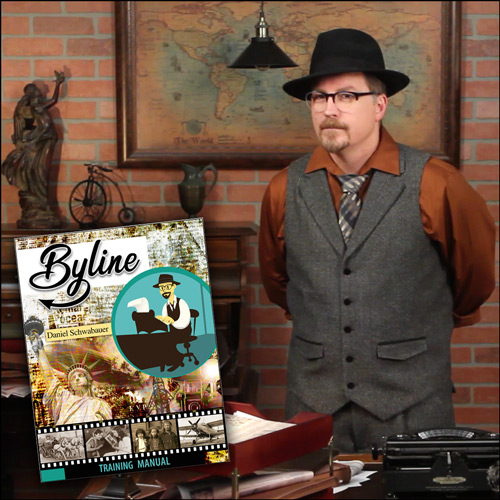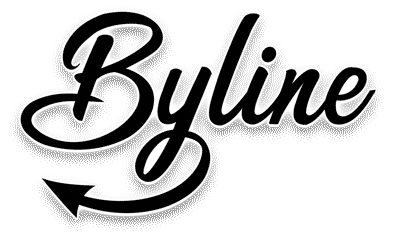How to Use & Grade Byline
This overview of how to use and grade Byline builds on the information on the About page.
Pacing
The suggested pace for Byline is to complete 3 lessons per week, for 24 weeks. But Byline is flexible! You can work in extra days where you need them and still fit the course into one school year.
Families
Families usually schedule 3 separate days a week (M-W-F) and focus on one lesson at a time.
Schedule about 45 minutes to 1 hour for each lesson, including watching the video. Each lesson begins with a 15–20-minute video. Students then proceed to work in the Training Manual and Reporter’s Notebook, following the direction provided in the video.
The average student will spend 4.5-5 hours per week on Byline when following the suggested pace of three lesson per week. It’s possible your student will need more that 5 hours if he or she tends towards wordiness or is an avid writer who really enjoys creative projects. We intentionally build in some “wiggle room” in planning the number of lessons for a school year!
Co-ops, Study Groups, and Schools
To read about using Byline in a group setting, check out the “Using Our Programs in a Co-op or Group” page.
Getting Started
Making Sure You Have What You Need
If you ordered a Cloud video streaming set:
After purchasing, you will receive an access password by email. Please save this password! Go to the Cloud video portal under the “Resources” tab on the Byline webpage, or just click the link provided in the email. Enter the email address you provided at checkout and your new password.
Once logged in, you can click on the course icon to begin viewing. The lesson videos are grouped in threes by week
You do need the physical materials before you can properly begin. The physical materials—The Training Manual, Reporter’s Notebook, Teacher’s Guide, and The Metropolitan World and Retro Metro newspapers—will ship to you by USPS Priority Mail. A tracking number will be sent by email.
If you ordered a DVD set:
All materials—the DVDs, The Training Manual, Reporter’s Notebook, Teacher’s Guide, and The Metropolitan World and Retro Metro newspapers—will ship to you by USPS Priority Mail. A tracking number will be sent by email.
What to Do First
- Watch the Parents & Teachers video.
- Read through the introductory pages in the Teacher’s Guide.
- Watch the How to Use Byline video with your student.
That’s it! Your student is ready for the lessons.
How to Complete a Lesson
- Watch the Video. Every single lesson in Byline begins with a video (15–20 minutes). Daniel Schwabauer provides direction from within the video lesson. You will not need to tell your student what to do when the video lesson ends—the student will receive instructions from the video.
- Proceed to The Training Manual and Reporter’s Notebook, as directed by the instructor, in the video.

How to Use the Printed Newspapers
The Metropolitan World and the Retro Metro are both designed to provide students with examples of the pieces of writing assigned in Byline. The examples in the Metropolitan World are written by the instructor himself, in the persona of the Editor in Chief. The articles in the Retro Metro are real, historical pieces of journalism by writers like Nellie Bly, Mark Twain, and Ernest Hemingway.
- These newspapers are not required reading, but they will give definition to your student’s ideas, and inspire greater creativity.
- Your student can read them at any point, but the Training Manual alerts the student to relevant examples they can find in these newspapers.
- Your student should not expect to write “just like” Hemingway or Twain—or even just like their “boss,” Editor in Chief Daniel Schwabauer—but the articles serve as examples of what real journalists write.
- Please note that where the instructions and the example articles differ, the student should follow the instructions. Some of the sample historical articles are longer than the word count required in the course.
Insight into The Reporter’s Notebook
The clearest overview of The Reporter’s Notebook is in Video Lesson 2. If you find that your student is hesitant or confused about how to use the Notebook, we would recommend re-watching this lesson.
As “Mr. S.” explains in Lesson 2, the Notebook was designed to be used with every lesson, but not necessarily for every lesson. Some projects make greater use of it than others. But even if your student doesn’t use it very much for a specific project, he or she should still be using it, if only to practice the habits of observation, clear thinking, and (as the course progresses) source citation.
For those lessons that the student isn’t instructed to use it, we still suggest writing down questions and ideas and mysteries in the top section, and answers or facts or emotions in the bottom section. The point is to help students pay attention to life, and then practice capturing what they have noticed. Overheard conversations, visual details, quirky ideas, and questions all provide raw material for the imagination; they are a writer’s stock-in-trade.
Unit Tests
There is a test at the end of each of the six units. These tests are not cumulative. They are formatted as multiple-choice questions.
There are several ways your student can take the tests:
- The student can take the tests online, under “Resources.” Online tests are auto-graded. Your student can type your email address into the field at the top of the test so that a copy of the results is sent to your inbox.
- You can have the student take the tests on paper, whether directly in the Teacher’s Guide or by photocopying the tests in the Teacher’s Guide. (This is the only duplication permitted under the copyright.) Use the Answer Key in the Teacher’s Guide to grade.
- You can administer the tests orally, by reading out of the Teacher’s Guide. Use the Answer Key in the Teacher’s Guide to grade.
Where the Podcast Fits In
Yes, we have a Byline podcast, too! Mr. S.’s passion for story and history collide in this bimonthly look at some of the most fascinating and influential works of journalism from the past.
The Byline podcast and its archive of bonus reading are completely optional extras, and can be enjoyed by anybody, whether taking Byline or not. The episodes are not required listening for the course—that is, unless you want your student to earn the 0.5 credits of high school History as well. (Find out how to earn the extra 0.5 credits.). We do, however, suggest where certain episodes might best fit with the course in the Byline Syllabus and Lesson Table.
How to Grade Byline
Our Grading Philosophy
At Clear Water Press, we focus on teaching students how to get thoughts and ideas onto paper—or screen!—in a way that will compel a response from their intended audience. This means we are passionate about helping young writers separate the creative stage from the analysis stage. Why? Writers will not be as creative in their drafts if they are already worrying about analysis—about how the piece will be assessed and what they should do to polish their work. Writers also tend to respond poorly to correction and feedback in the excitement of creation. They are much more receptive to comments after a period of “cooling” the fire of their imagination, to get some emotional distance from what they wrote.
What this means for Byline is that we suggest that you wait until the end of each unit to grade the student’s work.
Here’s how it works:
Read the one-page summary for the week in the Teacher’s Guide. This will help you track with your student, so that when the end of the unit rolls around, you’ll already know what to focus on.
Keep an eye on your student. Glance over the Training Manual and Reporter’s Notebook about once a week, just to make sure your student is completing the work. No need to read at any depth.
Grade at the end of the unit—once per month! It will take one to two hours, but is easy to do. The Teacher’s Guide tells you how many points each assignment is worth and what to focus on.
Record the points in the tally sheets in the Teacher’s Guide. You will find simple instructions for calculating the percentage and grade value of the total points.
What real homeschooling parents have to say about Clear Water Press Teacher’s Guides:
“This is one of my favorite teacher’s guides ever! The explanations on how to use the curriculum are simple and straightforward. There is no guess work as to what you and your student need to do for each lesson and there are even weekly lesson guides inside if you like to follow a pre-set plan.”
– Misty Leask of Year Round Homeschooling. Read more »
“Not only is One Year Adventure Novel fun for my students, but it is also easy for me as the home school teacher to keep up with and grade.”
– Karen. D., Parent

